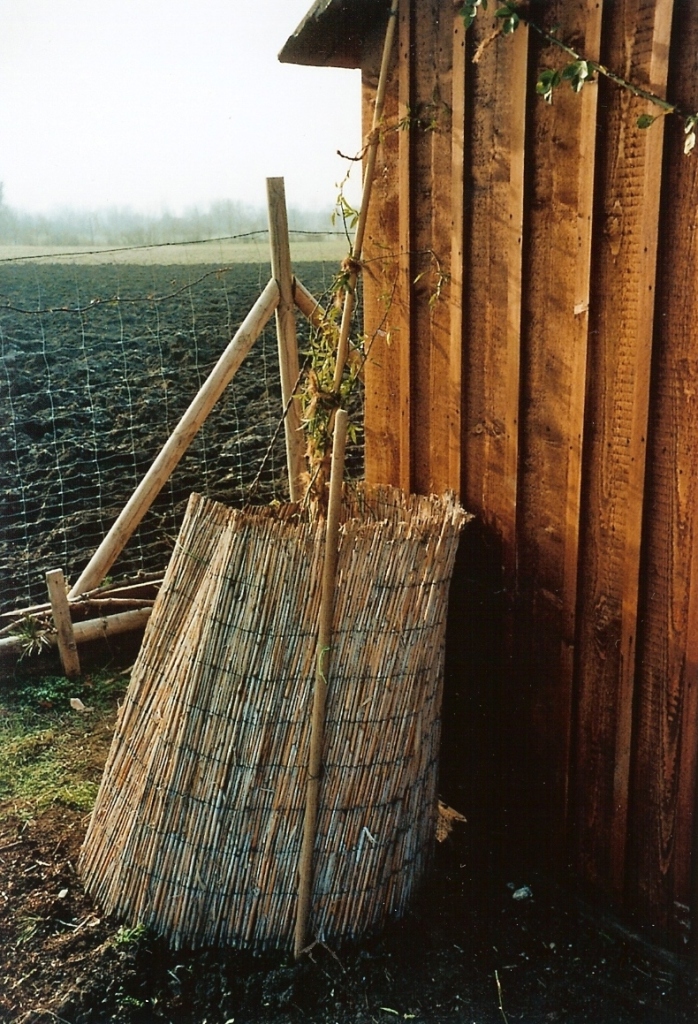Ako chrániť ruže v zime
„Ruže môže mať každý, ale mať ich zdravé po celý rok a bezpečne ich zazimovať, nevie nik.“ Rudolf Geschwind Die Rose und der Winter. In: Wiener Illustrirte Gartenzeitung, 1893
Takto začal Rudolf Geschwind svoj súhrnný článok o mrazuvzdornosti ruží a ochrane odrôd citlivých na zimné mrazy. Ako všetko, čo Geschwind o ružiach napísal, ani tento text nestratil nič zo svojej aktuálnosti ani po sto tridsiatich rokoch. Šľachtitelia, samozrejme, uspeli v hybridizácii mrazuvzdorných ruží, spomínali sme to v januárovom čísle, navyše také zimy, aké popisoval Geschwind, sme nikdy nezažili. Napriek tomu je užitočné porozumieť tomu, ako ruže dokážu odolať mrazu a čo môže záhradník urobiť pre to, aby vylepšil ich schopnosti.

zimná ochrana Rosa banksiae var. „Purezza„
Aby sme si veci zjednodušili, hovoríme jednoducho o mrazuvzdornosti, ale tá obsahuje tri rôzne aspekty. Pri jednotlivých odrodách zohľadňujeme teda rôzne aspekty mrazuvzdornosti.
- Odolnosť voči prvým jesenným mrazom
Najlepšou prevenciou proti poškodeniu prvými jesennými mrazmi je starať sa o zdravie a výživu svojich ruží počas jari a leta. Je dôležité vybrať ružiam vhodné stanovisko, nesadiť ich do tieňa ale na slnečné miesto. Nevhodné je aj vlhké podložie či tlak koreňov iných drevín.
2. Odolnosť voči pretrvávajúcim zimným mrazom
Túto vlastnosť takmer všetkých odrôd veľmi nedokážeme ovplyvniť. Samozrejme, mladé rastliny sú náchylnejšie než dospelé jedince. V poslednej dekáde zažívame zimy, kedy teploty iba zriedka klesnú pod -12°C počas zopár za sebou nasledujúcich dní. Väčšina ruží, ktoré kultivujeme, tým pádom nemá problém vydržať mrazy počas zimy.
3. Udržateľná mrazuvdornosť
Udržateľná mrazuvzdornosť je najpodstatnejším bodom ochrany ruží v zime. Ak ju rastliny stratia, nebudú schopné si ju následne vybudovať. Nedokážeme ochrániť naše ruže pred veľkými teplotnými výkyvmi, ale vieme ich ochrániť pred zimným slnkom a holomrázom v období neskorej zimy a skorej jari. Geschwindovu radu by sme nemali ignorovať, pomôže rovnako, ako v roku 1893.
Spodnú časť každej rastliny prikryte vrstvou pôdy do výšky približne 10 cm, aby ste vytvorili dodatočnú ochranu pre miesto, kde sa odroda naočkovala na podpník. Pomedzi konáre ruží umiestnite čečinu, aby ste im poskytli tieň pred zimným slnkom. Rovnako sa osvedčila sa aj trstinová rohožka namiesto čečiny. Tento typ ochrany sa odporúča najmä pre popínavky na múroch. Práve týmto odrodám môžu teplotné výkyvy značne ublížiť. Citlivé ruže prikryte ihličím úplne. Čím menej starého dreva ruža stratí, tým skôr a bohatšie kvitne.
TEXT ERICH UNMUTH FOTO ANDREA BUCHMANN
PREKLAD MARTINA ŠIMKOVIČOVÁ
Winter protection of roses
Thoughts inspired by Rudolf Geschwind
„Rosen besitzen kann Jedermann, sie dauernd gesunderhalten und schadlos durchwintern Niemand“ Rudolf Geschwind 1893 Die Rose und der Winter. In: Wiener Illustrirte Gartenzeitung
“Everybody can have roses but keeping them healthy all year round and hibernating them safe, nobody can.” (Translation E.U.)
With this verdict Rudolf Geschwind opened a comprehensive article about hardiness of roses and the protection of tender roses during the winter.
As all Geschwind wrote about roses this article didn’t lose its actuality during the last 130 years. Of course rose breeding was successful in hybridizing hardy roses, we discussed that in the January issue. And winters Geschwind reported we never had to face. But nevertheless it is useful to understand how roses withstand frost and what a gardener can do to improve their ability.
Simplified we are talking just of hardiness but that incorporates 3 elements which are unique to each rose variety.
- Frost-resistance against the first freeze in autumn
Keeping Your roses healthy and well-fed during spring and summer will be the best prevention from damages by the first freeze in autumn. It is essential to grow roses on suitable locations, not in shady places but in sunny, not in moisty ground, without root pressure from wood.
2. Frost-resistance against enduring winter freeze
This second element is almost a feature of each variety which You cannot affect much, of course young plants are more tender than adult ones. During the last decade temperatures rarely dropped below -12°C for more than a few days, most of the roses we are cultivating don’t have any problems with enduring winter freeze.
3. Steadiness of frost-resistance
Keeping the frost-resistance is the cardinal point of winter protection. If roses are losing their frost-resistance they cannot build it up a second time. We cannot protect our roses from the massive variations in temperature but we can protect them from additional effects like sun and bare frost in late winter and early spring. Geschwind’s advice we should not ignore, today they are as helpful as they were in 1893.
The basis of each plant should be covered with approx. 10cm additional soil as an additional shelter for the union where the variety is budded to the root. Brushwood should be placed between the branches of the rose to shadow them from insolation. Instead of brushwood using rush mat turned out to be a substitute of equal value. That is especially recommended for climbers which are trained on walls. Here variations in temperature can be much more harmful. Tender roses should be covered with brushwood completely. The less old wood the rose loses the earlier and the more it will bloom.
12 thoughts on “Ako chrániť ruže v zime”
Comments are closed.